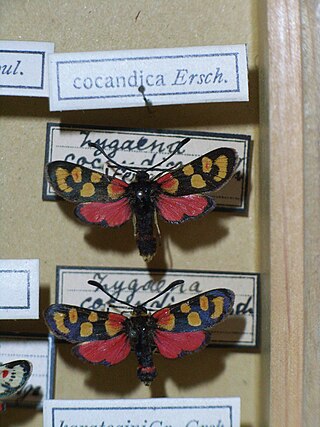
Zygaena transalpina is a moth of the family Zygaenidae.

Zygaena is a genus of moths in the family Zygaenidae. These brightly coloured, day-flying moths are native to the West Palearctic.

Zygaena carniolica, sometimes described as the crepuscular burnet or eastern burnet, is a member of the family Zygaenidae.

Zygaena ephialtes is day-flying species of burnet moth found in Europe. It is typically found in xeric habitats, and populations have recently decreased. It also exhibits Müllerian mimicry with other species, like Amata phegea.

Zygaena fausta is a member of the family Zygaenidae, the day-flying burnet moths. Its bright aposematic colours of red, white and black on the wings indicate to possible predators such as birds that it is foul tasting or poisonous. In flight, the bright red abdomen is revealed, contrasting with the white legs and black head and antennae; the thorax is black and white with an eye spot on each side. There appears to be a considerable variation in pattern among specimens from different parts of Europe.

Zygaena purpuralis, the transparent burnet, is a moth of the family Zygaenidae.

Zygaena occitanica, the Provence burnet, is a moth of the Zygaenidae family. It is found from the Algarve and southern Spain up to the eastern parts of the Cantabrian Mountains then to southern Russia and the Caucasus and east to the western fringe of Central Asia.

Zygaena cocandica is a moth of the family Zygaenidae. It is found in Uzbekistan, Tajikistan and Kyrgyzstan. In Seitz it is described as "A very remarkable form with yellow spots on the forewing, only the basal ones being shaded with red, it has sometimes an entirely red abdomen ab.karategini Gr.-Grsh., from Buchara" Also in Seitz as erschoffi Stgr. it is described as having "spots 5 and 6 often widely separate, standing side by side rather than one below the other; collar and 1-2 abdominal segments red, sometimes also the shoulders, as in our last figure: Pamir". The length of the forewings is about 12 mm.

Zygaena sarpedon is a moth of the Zygaenidae family. It is found in France, Italy and on the Iberian Peninsula.

Zygaena hilaris is a species of moth in the family Zygaenidae.

Zygaena sedi is a species of moth in the Zygaenidae family. It is found in Greece, Bulgaria, Turkey, Ukraine and Russia. In Seitz it is described - Z. sedi Fab. (6k). In this insect the spots of each pair are merged to large light red patches, these being separated from each other only by thin lines of the transparent ground-colour. Abdomen without belt. Coasts of the Black Sea.

Zygaena brizae is a species of moth in the Zygaenidae family. It is found in France, Italy, Austria, the Czech Republic, Poland, Slovakia, Hungary, the Balkan Peninsula, Moldova, Ukraine, Russia, Turkey and Georgia.

Zygaena cynarae is a species of moth in the Zygaenidae family. It is found from France east to Russia.

Zygaena erythrus, common name sluggish burnet, is a species of moth in the family Zygaenidae.

Zygaena punctum is a species of moth in the family Zygaenidae. It is found in Poland, the Czech Republic, Slovakia, Austria, Slovenia, Italy, the Balkan Peninsula, Moldova, Ukraine, Russia and Turkey.

Zygaena rubicundus, common name fulvous burnet,. is a species of moth in the family Zygaenidae.

Zygaena rhadamanthus is a species of moth in the Zygaenidae family. It is found in France, Spain, Portugal and Italy.

Zygaena kavrigini is a species of moth in the Zygaenidae family. It is found in Central Asia. Seitz states Z. kavrigini Gr.-Grsh. has the abdomen mostly entirely red, inclusive of base; from Kuchara. The larva feeds on Alhagi canescens

Zygaena truchmena is a species of moth in the Zygaenidae family. It is found in Central Asia.

Zygaena niphona is a species of moth in the Zygaenidae family. It is found in the east Palearctic. In Seitz it is described Z. niphona Btlr. (6e). The only Burnet from East Asia. Rather large, sparsely scaled, 5 spotted, with rather wide red abdominal belt. Club of antenna strongly incrassate at apex. The insect has the appearance of a large meliloti, but the body is strong and robust, the flight however being nevertheless not at all fast. Though the species varies considerably, some specimens being 6 spotted and resembling therefore Z. peucedani, there are no local races. The abdominal belt occupies mostly 2 segments, but is sometimes restricted to one segment, the posterior portion of the abdomen being occasionally all red. The species is widely distributed in Japan, especially at low altitudes of the central mountains, near and on the Fujisan; probably more sporadic in Amurland, since Graeser did not meet with it.





















